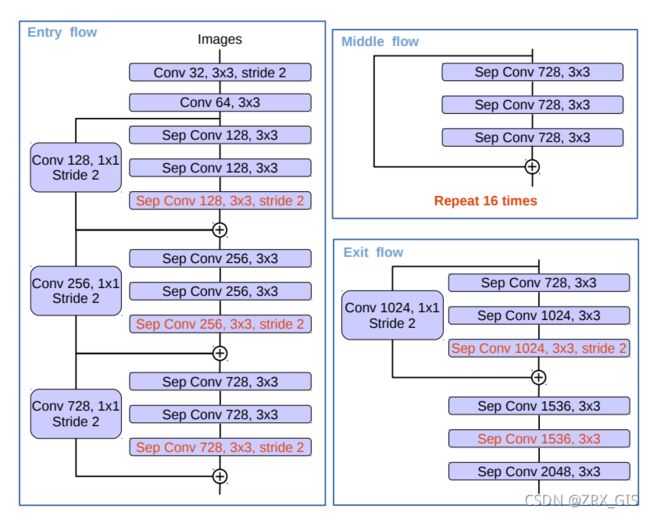import torch
import torchvision.models as models
from torch import nn
class SeparableConv2d_same(nn.Module):
def __init__(self, inplanes, planes, kernel_size=3, stride=1, dilation=1, bias=False):
super(SeparableConv2d_same, self).__init__()
self.conv1 = nn.Conv2d(inplanes, inplanes, kernel_size, stride, 0, dilation,
groups=inplanes, bias=bias)
self.pointwise = nn.Conv2d(inplanes, planes, 1, 1, 0, 1, 1, bias=bias)
def forward(self, x):
x = self.conv1(x)
x = self.pointwise(x)
return x
class Block(nn.Module):
def __init__(self, inplanes, planes, reps, stride=1
, dilation=1, start_with_rule=True, grow_first=True, is_last=False):
super(Block, self).__init__()
if planes != inplanes or stride != 1:
self.skip = nn.Conv2d(
inplanes, planes, 1, stride=stride, bias=False
)
self.skipbn = nn.BatchNorm2d(planes)
else:
self.skip = None
self.relu = nn.ReLU(inplace=True)
rep = []
filters = inplanes
if grow_first:
rep.append(self.relu)
rep.append(SeparableConv2d_same(
filters, planes, 3, stride=1, dilation=dilation
))
rep.append(nn.BatchNorm2d(planes))
filters = planes
for i in range(reps - 1):
rep.append(self.relu)
rep.append(SeparableConv2d_same(
filters, filters, 3, stride=1, dilation=dilation
))
rep.append(nn.BatchNorm2d(filters))
if not grow_first:
rep.append(self.relu)
rep.append(SeparableConv2d_same(
inplanes, planes, 3, stride=1, dilation=dilation
))
rep.append(nn.BatchNorm2d(planes))
if not start_with_rule:
rep = rep[1:]
if stride != 1:
rep.append(SeparableConv2d_same(planes,
planes, 3, stride=2))
if stride == 1 and is_last:
self.rep = nn.Sequential(*rep)
def forward(self, input):
x = self.rep(input)
if self.skip is not None:
skip = self.skip(input)
skip = self.skipbn(skip)
else:
skip = input
x += skip
return x
class Xception(nn.Module):
def __init__(self, inplanes=3):
super(Xception, self).__init__()
entry_block3_stride = 2
middle_block_dilation = 1
exit_block_dilations = (1, 2)
self.conv1 = nn.Conv2d(inplanes, 32, 3, stride=2, padding=1, bias=False)
self.bn1 = nn.BatchNorm2d(32)
self.relu = nn.ReLU(inplace=True)
self.conv2 = nn.Conv2d(32, 64, 3, stride=1, padding=1, bias=False)
self.bn2 = nn.BatchNorm2d(64)
self.block1 = Block(64, 128, reps=2, stride=2, start_with_relu=False)
self.block2 = Block(128, 256, reps=2, stride=2, start_with_relu=True, grow_first=True)
self.block3 = Block(256, 728, reps=2, stride=entry_block3_stride, start_with_relu=True, grow_first=True,
is_last=True)
self.block4 = Block(728, 728, reps=3, stride=1, dilation=middle_block_dilation, start_with_relu=True,
grow_first=True)
self.block5 = Block(728, 728, reps=3, stride=1, dilation=middle_block_dilation, start_with_relu=True,
grow_first=True)
self.block6 = Block(728, 728, reps=3, stride=1, dilation=middle_block_dilation, start_with_relu=True,
grow_first=True)
self.block7 = Block(728, 728, reps=3, stride=1, dilation=middle_block_dilation, start_with_relu=True,
grow_first=True)
self.block8 = Block(728, 728, reps=3, stride=1, dilation=middle_block_dilation, start_with_relu=True,
grow_first=True)
self.block9 = Block(728, 728, reps=3, stride=1, dilation=middle_block_dilation, start_with_relu=True,
grow_first=True)
self.block10 = Block(728, 728, reps=3, stride=1, dilation=middle_block_dilation, start_with_relu=True,
grow_first=True)
self.block11 = Block(728, 728, reps=3, stride=1, dilation=middle_block_dilation, start_with_relu=True,
grow_first=True)
self.block12 = Block(728, 728, reps=3, stride=1, dilation=middle_block_dilation, start_with_relu=True,
grow_first=True)
self.block13 = Block(728, 728, reps=3, stride=1, dilation=middle_block_dilation, start_with_relu=True,
grow_first=True)
self.block14 = Block(728, 728, reps=3, stride=1, dilation=middle_block_dilation, start_with_relu=True,
grow_first=True)
self.block15 = Block(728, 728, reps=3, stride=1, dilation=middle_block_dilation, start_with_relu=True,
grow_first=True)
self.block16 = Block(728, 728, reps=3, stride=1, dilation=middle_block_dilation, start_with_relu=True,
grow_first=True)
self.block17 = Block(728, 728, reps=3, stride=1, dilation=middle_block_dilation, start_with_relu=True,
grow_first=True)
self.block18 = Block(728, 728, reps=3, stride=1, dilation=middle_block_dilation, start_with_relu=True,
grow_first=True)
self.block19 = Block(728, 728, reps=3, stride=1, dilation=middle_block_dilation, start_with_relu=True,
grow_first=True)
self.block20 = Block(728, 1024, reps=2, stride=1, dilation=exit_block_dilations[0],
start_with_relu=True, grow_first=False, is_last=True)
self.conv3 = SeparableConv2d_same(1024, 1536, 3, stride=1, dilation=exit_block_dilations[1])
self.bn3 = nn.BatchNorm2d(1536)
self.conv4 = SeparableConv2d_same(1536, 1536, 3, stride=1, dilation=exit_block_dilations[1])
self.bn4 = nn.BatchNorm2d(1536)
self.conv5 = SeparableConv2d_same(1536, 2048, 3, stride=1, dilation=exit_block_dilations[1])
self.bn5 = nn.BatchNorm2d(2048)
def forward(self, x):
x = self.conv1(x)
x = self.bn1(x)
x = self.relu(x)
x = self.conv2(x)
x = self.bn2(x)
x = self.relu(x)
x = self.block1(x)
low_level_feat = x
x = self.block2(x)
x = self.block3(x)
x = self.block4(x)
x = self.block5(x)
x = self.block6(x)
x = self.block7(x)
x = self.block8(x)
x = self.block9(x)
x = self.block10(x)
x = self.block11(x)
x = self.block12(x)
x = self.block13(x)
x = self.block14(x)
x = self.block15(x)
x = self.block16(x)
x = self.block17(x)
x = self.block18(x)
x = self.block19(x)
x = self.block20(x)
x = self.conv3(x)
x = self.bn3(x)
x = self.relu(x)
x = self.conv4(x)
x = self.bn4(x)
x = self.relu(x)
x = self.conv5(x)
x = self.bn5(x)
x = self.relu(x)
return x, low_level_feat

